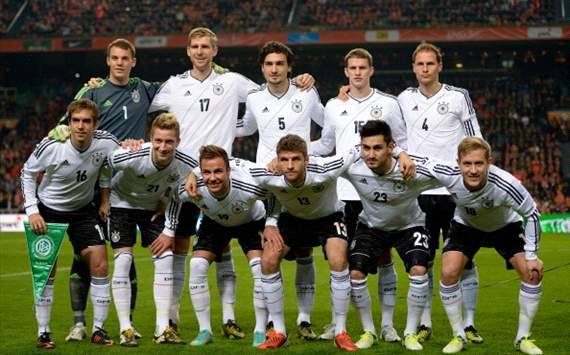The Bundesliga blueprint that has the German league taking over Europe
Written by: Clark whitney.
Goal.com.
Germany has finally woken up from its self-induced coma, and clubs such as Bayern Munich, Schalke and Borussia Dortmund are ready to take the Champions League by storm..
Ruthless efficiency, mental fortitude to win
by any means necessary, impeccable organisation of a wall of chiseled,
blond-haired and blue-eyed defenders ... these are the traditional
stereotypes of German football.
A decade ago, but for a few more
players of darker features, Rudi Voller’s national team had fitted all
the aforementioned criteria. Die Mannschaft played simple but
effective football, conceding just once en route to the 2002 World Cup
final in Yokohama. However, they were comprehensively outclassed by a
Brazil side who went on to secure their fifth title with a 2-0 victory.
At the time, German hopes rested on luck: a
poor performance by the opposition, a scrappy goal from a set piece or
an extensive and diverse crop of talents to emerge from the Bundesliga
academies.
Germany were an underwhelming side 10 years ago. But
by then, the DFB (German FA) had already planted the seeds for an
entirely new footballing philosophy. It just needed time.
It
all started in 2000 after Germany disgracefully exited the European
Championship, having only gained a single point in a group which
included Portugal, Romania and England. Luck had deserted the Nationalmannschaft,
which looked old and devoid of any inspiration, and had few talents to
look forward to down the road. In response, the DFB revolutionised the
system of youth development in Germany.
2011 REVENUE OF EUROPE'S BIG FOUR LEAGUES - EXCLUDING TRANSFERS

Premier League
Bundesliga
La Liga
Serie A
€2,515m
€1,746m
€1,718m
€1,553m
Source: Deloitte
In December of 2000, the DFB created the DFL (German Football
League) to manage the 1. and 2. Bundesliga. Shortly after its creation,
the DFL enacted strict mandates for clubs to get their licence to join
the league. All teams in the top two tiers of German football were
required to have for their academies: a certain number of training
pitches, an indoor training facility, massage rooms, saunas, and
physiotherapists. In addition, the DFL raised the bar for obtaining a
coaching licence at youth level.
The DFL’s initiative to promote
youth development was beneficial, not only for the German national
team, but for Bundesliga sides, which were at a competitive disadvantage
on the international stage, following the passing of the DFB’s “50+1”
rule at the turn of the millennium.
Enacted to promote
competition within the league and ensure the importance of fans in
Bundesliga culture, the 50+1 rule requires that members must own at
least 51 per cent of the club — thus eliminating the possibility of a
Roman Abramovich or Sheikh Mansour-type staging a takeover.
In
the years that followed, German football struggled. The 50+1 law
especially hindered Bundesliga clubs’ success in the Champions League,
as their spending power paled in comparison to Europe’s nouveau-riche.
The academies took time to grow, and the players — starting before their
teens — took time to mature.
The DFL’s vision was one for the
long term and it changed the culture of Bundesliga football. Coaches
became progressively trusting of young players, and as more and more
talents emerged, the clubs' trainers developed an ardent belief in the
notion that “talent without end” was attainable.
Now 13 years
after the 50+1 rule and 12 years after the DFL’s licensing initiative,
Bundesliga sides are finally beginning to flex their muscle on the
international stage. A couple of disappointing domestic seasons forced
the traditional powers to become more ambitious in the transfer market,
which has bred success on the continent. And in this season’s Champions
League, Dortmund and Schalke have emerged as European powerhouses. The
latter are poised to win Group B ahead of Arsenal, while the former won
Group D with a game to spare ahead of Real Madrid, Manchester City and
Ajax.

THE LEAGUE OF THE FUTURE
The Bundesliga in numbers
€1.94b
Total revenue in 2010-11
€70.86m
Investment in academies 2010-11
€215m
Increase of annual broadcast revenue from 2013-14
€130.4m
Combined profit of clubs after tax
42,101
Number of fans per match
Source: Bundesliga
The success of Bundesliga clubs this season falls in line with an
overall progress the league has seen lately. Bayern have reached two
Champions League finals in three years, and their squad has steadily
improved each term since 2009.
Schalke’s run to the semi-finals
in 2010 proved that Bayern are not the only German club that can compete
in the Champions League, while Dortmund’s performances in Europe this
season suggest that in a two-legged tie, they have no-one to fear.
Looking
forward, there is only reason to believe the Bundesliga will continue
its ascent, with the honour of being Europe’s top league a long-term
possibility. All the league’s stars are under 30 years of age, and in
using loyal, local talents, Bayern and Dortmund have created sustainable
success while avoiding the toxic culture of being used as a
“stepping-stone” club. Arsenal, take note.
With Financial Fair
Play set to take effect in 2013-14, the Bundesliga’s greatest advantage —
its business structure — will soon show its value. Already, Europe's
top sides like AC Milan and Manchester United have curbed spending in
fear of sanctions by Uefa. Many more will follow, but German teams have
little to worry about in Financial Fair Play. Revenue in the country’s
top flight is second only to that of the Premier League, and will only
grow with the German league’s success. The Bundesliga has already landed
a new deal with Sky that will see TV revenue increase 52 per cent to €628 million per year beginning in 2013-14.
Profits
in the Bundesliga are as high as any other of the top leagues in
Europe, and debt is a fraction of that in England, Italy, and especially
Spain. A comparison of liability to turnover reveals just how close
Spanish football is to financial collapse: debt in La Liga is 246 per
cent of revenue. Even Barcelona owe €48m in unpaid taxes to the Spanish
government — the same Spanish government that, ironically, received
hundreds of millions of Euros in a bailout package from Germany.
Serie
A has been in a financial and sporting nosedive as of late, and this
will not change before the Italian economy recovers. Only the Premier
League can compete with the Bundesliga’s financial might, but high
debts, the uncertainty of Manchester City, Chelsea’s compliance with
Financial Fair Play and the overall stronger German economy suggest the
Bundesliga could overtake the English top flight in terms of wealth and
revenue.
For most of the 2000s, German football was in a
self-induced coma. Since then, a bounty of talents have emerged and
clubs have enjoyed steadily increasing financial and international
sporting success. Backed by Europe’s strongest economy and an organic
sporting and financial model, German football is approaching not a
golden generation, but sustainable, continued success.

Bundesliga
La Liga
Serie A
€1,746m
€1,718m
€1,553m
The Bundesliga in numbers

No comments:
Post a Comment